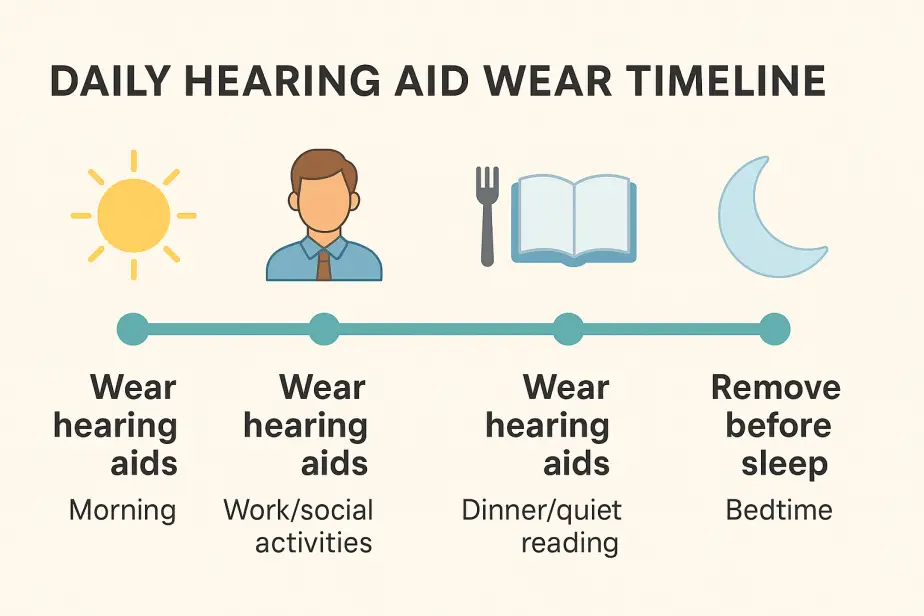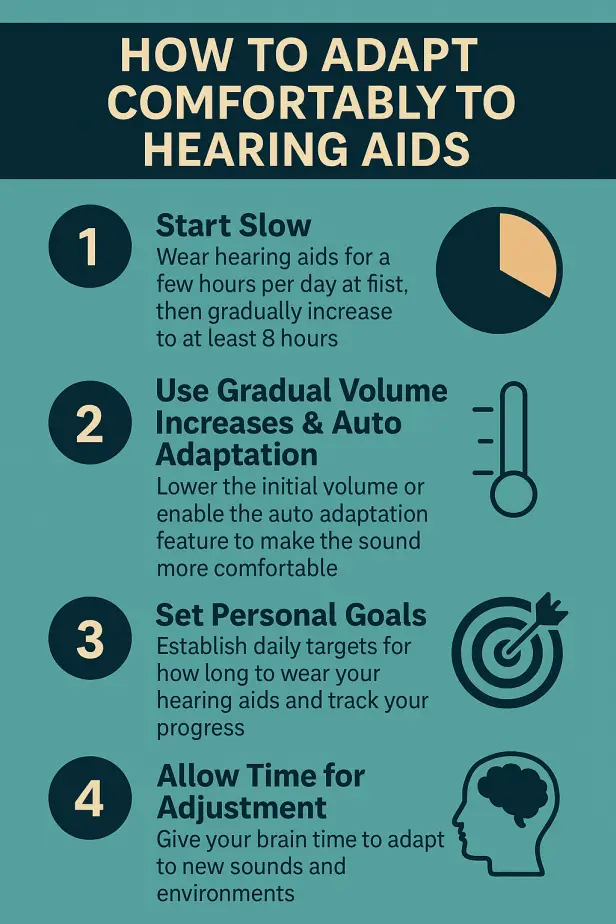Discover the optimal duration for wearing hearing aids — and why consistent use is key to brain adaptation, communication, and long-term success.
One of the most common questions I hear from patients is: “How many hours a day should I wear my hearing aids?”
The short answer is simple but life-changing: wear them as much as possible during your waking hours.
As an audiologist who has fit thousands of patients, I’ve seen firsthand how consistent use transforms communication, listening comfort, and overall quality of life.
In this article, you’ll learn why full-time wear is so important, how to adapt comfortably, when to remove your devices, and what to do if you dislike your current hearing aids.
Why Consistency Is Essential for Brain Adaptation

Your brain thrives on consistent stimulation — and that includes sound. Wearing your hearing aids all day ensures your auditory system stays active, even in quiet situations like reading at home. This continuous input helps your brain process speech and environmental sounds more effectively.
- Noise readiness: Wearing them only in “difficult” listening situations leaves your brain unprepared for noisy environments.
- Better adaptation: Consistent exposure trains your brain to handle both quiet and loud settings — making transitions seamless.
- Higher satisfaction: A 2020 study in Ear and Hearing found that patients who wore hearing aids 10+ hours daily had better speech-in-noise scores than those wearing them less than 4 hours.
👉 Also see: Hearing Aids Help Communication
Overcoming the Challenges of Adaptation

For many people, hearing loss develops gradually, so wearing hearing aids can feel overwhelming at first. You’re essentially reintroducing your brain to sounds it hasn’t processed in years.
Think of it like training for a marathon — you build endurance over time.
- Start slow: Begin with just a few hours daily, then gradually increase to at least 8 hours.
- Expect adjustments: Your audiologist can fine-tune programming to ease the transition.
- Patient story: One of my patients wore hearing aids only “when needed” for the first few months. They constantly complained of overwhelming noise. After committing to full-day wear, within 6 weeks they reported clearer conversations and less listening fatigue.
Using Gradual Volume Increases & Auto Adaptation
Many modern hearing aids include auto adaptation — a feature that gradually raises amplification to the prescribed level over days or weeks.
- Tip: If you feel overwhelmed by loudness, ask your audiologist to enable this feature.
- Alternative: Start at a reduced volume and increase as you adapt.
Setting Personal Goals
Breaking adaptation into small, achievable steps makes the process less stressful.
- Day 1: Wear for 2 hours.
- Add 30 minutes daily until you reach full-day wear.
- Track your progress — many hearing aids now have companion apps that monitor usage time.
👉 For more on hearing aid journeys, see Everything to Know About Hearing Aids
Common Mistakes to Avoid
- Only wearing aids at social events → The brain doesn’t get steady practice.
- Taking them out in quiet rooms → Quiet listening is still valuable input.
- Wearing only one aid when two are prescribed → This halves your brain’s natural sound-processing ability.
- Giving up too soon → Adaptation takes weeks, not days.
When to Take Your Hearing Aids Off
While “all day” wear is ideal, there are times you should remove your devices:
- During sleep — Prevents discomfort, skin irritation, and damage.
- Before water exposure — Even water-resistant models aren’t made for showers or swimming.
- During very loud activities — Remove aids and use hearing protection for mowing, shooting, or concerts. (Guide on safe practices)
Special Considerations
- Children: Nearly full-time use is essential for speech and language development.
- Seniors over 70: May need a slower, more gradual adaptation schedule.
- Tinnitus patients: Consistent use can reduce ringing perception by providing masking.
What to Do If You Don’t Like Your Hearing Aids
If you’re unhappy with your devices, act quickly during the trial or return period.
| Problem | Solution |
|---|---|
| Sound is uncomfortable | Visit your audiologist for adjustments. |
| Style is inconvenient | Try switching (BTE → RIC, or to more discreet custom options). |
| Tech feels outdated | Consider upgrading to newer models with better noise reduction. |
| Feeling discouraged | Join support groups or seek counseling for hearing loss adaptation. |
👉 Also read: Best Hearing Aid Recommendations
FAQs
Can I wear my hearing aids 24/7?
No — remove them at night to let your ears rest and to protect the devices.
What if I only have mild hearing loss?
Consistent wear is still recommended. Even in mild cases, steady input helps the brain adapt and reduces listening fatigue.
How long does it take to fully adapt?
Most patients adapt within 4–6 weeks of daily use, though some take longer.
Is it harmful if I skip a few days?
It won’t undo progress completely, but it can slow adaptation. Consistency is best.
Final Thoughts from an Audiologist
Wearing your hearing aids consistently is one of the most powerful choices you can make for your hearing health. Think of it not as a medical device you “sometimes” use, but as an everyday tool — like glasses — that restores clarity and confidence in every conversation.
👉 Ready to learn more? Explore Everything to Know About Hearing Aids for a full guide.
Written by Jonathan Javid, Au.D., clinical audiologist with 14+ years of experience and over 10,000 patients seen. Founder of HearingInsider.com, specializing in evidence-based guidance for hearing aid users.

